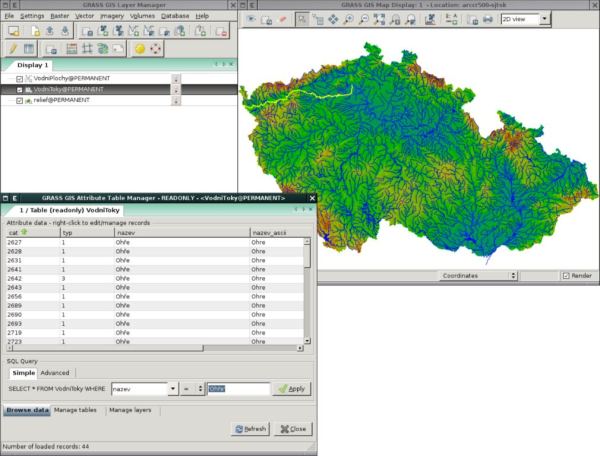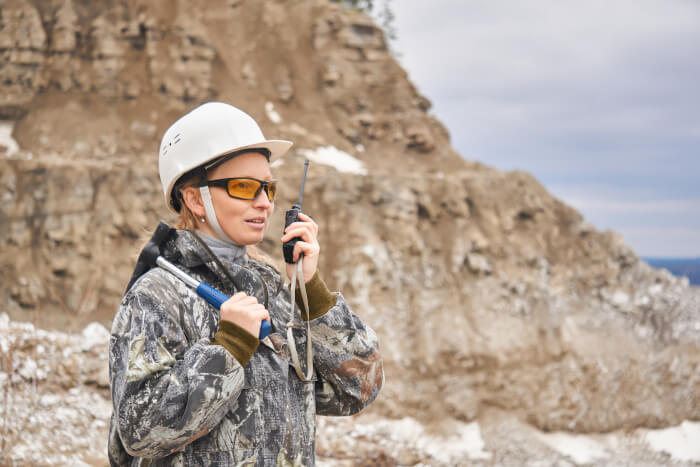Geographic Resources Analysis Support System (GRASS) is an open source Geographic Information System (GIS) used for geospatial data management and analysis, image processing, graphics/maps production, spatial modeling, and visualization.
It consists of more than 400 modules for processing vector (2D/3D), raster and voxel data. Many interfaces to other programs in related domains like geostatistics, databases, mapserver and even other GIS software exist.
It can serve as a Desktop GIS and as the backbone of a complete GIS infrastructure.
It was created in the 1980s by the US Army Corps of Engineers, Construction Engineering Research Laboratory (USA/CERL) and has been enhanced by many others.
GRASS is currently used in scientific applications, commercial settings and by public officials all over the world.
Features include:
- wxPython graphical user interface (wxGUI):
- Layer Manager – includes map layer management, integrated command-line prompt, and command output window tab.
- Map Display Window – integrates basic tools for zooming, panning, data querying, and map elements (north arrows, barscale, etc.).
- Module dialogs enable running GRASS modules.
- 2D raster analysis and 3D voxel management (volumes).
- 2D/3D Vector engine with SQL based DBMS support.
- Image processing modules.
- Vector network analysis, Linear Referencing System.
- Visualization of 2D, 3D maps and volumes.
- Interoperable with standard raster and vector formats.
- Modular architecture and scripting capabilities for batch processing.
- Supports various RDBMS (Relational database management system) and embedded databases. SQL (Structured Query Language) queries are directly passed to the underlying database system.
- Over 400 built-in analysis modules and 100 community supplied add-on modules and toolboxes can be downloaded for free.
- Python interface to the C library – create new modules in a simple way while at the same time creating powerful and fast modules.
- Can be used either as a stand-alone application or as backend for other software packages such as QGIS and R geostatistics.
Website: grass.osgeo.org
Support: Documentation, Quickstart, FAQ, Mailing Lists
Developer: Refractions Research
License: GNU Lesser General Public License

GRASS is written in C, C++, and Python. Learn C with our recommended free books and free tutorials. Learn C++ with our recommended free books and free tutorials. Learn Python with our recommended free books and free tutorials.
Return to Scientific | Return to Earth Science
| Popular series | |
|---|---|
| The largest compilation of the best free and open source software in the universe. Each article is supplied with a legendary ratings chart helping you to make informed decisions. | |
| Hundreds of in-depth reviews offering our unbiased and expert opinion on software. We offer helpful and impartial information. | |
| The Big List of Active Linux Distros is a large compilation of actively developed Linux distributions. | |
| Replace proprietary software with open source alternatives: Google, Microsoft, Apple, Adobe, IBM, Autodesk, Oracle, Atlassian, Corel, Cisco, Intuit, and SAS. | |
| Awesome Free Linux Games Tools showcases a series of tools that making gaming on Linux a more pleasurable experience. This is a new series. | |
| Machine Learning explores practical applications of machine learning and deep learning from a Linux perspective. We've written reviews of more than 40 self-hosted apps. All are free and open source. | |
| New to Linux? Read our Linux for Starters series. We start right at the basics and teach you everything you need to know to get started with Linux. | |
| Alternatives to popular CLI tools showcases essential tools that are modern replacements for core Linux utilities. | |
| Essential Linux system tools focuses on small, indispensable utilities, useful for system administrators as well as regular users. | |
| Linux utilities to maximise your productivity. Small, indispensable tools, useful for anyone running a Linux machine. | |
| Surveys popular streaming services from a Linux perspective: Amazon Music Unlimited, Myuzi, Spotify, Deezer, Tidal. | |
| Saving Money with Linux looks at how you can reduce your energy bills running Linux. | |
| Home computers became commonplace in the 1980s. Emulate home computers including the Commodore 64, Amiga, Atari ST, ZX81, Amstrad CPC, and ZX Spectrum. | |
| Now and Then examines how promising open source software fared over the years. It can be a bumpy ride. | |
| Linux at Home looks at a range of home activities where Linux can play its part, making the most of our time at home, keeping active and engaged. | |
| Linux Candy reveals the lighter side of Linux. Have some fun and escape from the daily drudgery. | |
| Getting Started with Docker helps you master Docker, a set of platform as a service products that delivers software in packages called containers. | |
| Best Free Android Apps. We showcase free Android apps that are definitely worth downloading. There's a strict eligibility criteria for inclusion in this series. | |
| These best free books accelerate your learning of every programming language. Learn a new language today! | |
| These free tutorials offer the perfect tonic to our free programming books series. | |
| Linux Around The World showcases usergroups that are relevant to Linux enthusiasts. Great ways to meet up with fellow enthusiasts. | |
| Stars and Stripes is an occasional series looking at the impact of Linux in the USA. | |
